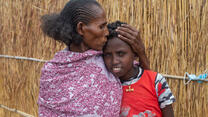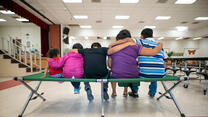
Right now, more people have been forced to flee their homes than ever before, with a staggering 110 million individuals displaced worldwide, according to a report released by the United Nations High Commissioner for Refugees (UNHCR). This is more than any other time since World War II.
From the war in Ukraine to ongoing conflict in Syria, to climate shocks and economic turmoil in East Africa and Latin America—global instability is increasing. At the end of 2022, the number was at 108 million, rising to 110 in just the first few months of 2023.
Unfortunately, many families and individuals who seek safety and refuge are not met with open arms. Too many governments and politicians, including some in the United States, mistakenly believe that cruelty and inhumanity are the best options for establishing order at their borders. In reality, often these solutions empower people smugglers and put those seeking safety into further danger.
Here’s what you need to know about this unprecedented humanitarian crisis:

What’s the difference between asylum seekers and refugees?
The 110 million number from UNHCR includes refugees, asylum seekers and internally displaced persons.
Refugees are people forced to flee their homes, that cross an international border in order to flee war, violence or persecution. They are unable to return home until conditions in their native lands are safe.
An official entity such as a government or UNHCR determines refugees status; those who obtain it are given protections under international laws and conventions and lifesaving support from aid agencies, including the International Rescue Committee (IRC). Some may be eligible for resettlement in a third country, such as the U.S.
Asylum seekers are people seeking international protection from dangers in their home country, but whose claim for refugee status hasn’t been determined legally. Asylum seekers must apply for protection in the country of destination—meaning they must arrive or cross a border in order to apply.
Internally displaced persons (often referred to as IDPs) have been forced to flee their homes because of war, violence or persecution, but have not crossed an international border. At the end of 2022, over 62.5 million people around the world were internally displaced, including 6.8 million in Syria and 5.4 million in Ukraine.

Where do most refugees and asylum seekers come from?
By the end of 2022, more than half of all refugees (52%), including others in need of international protection, were from Syria, Ukraine and Afghanistan.
After 12 years of war, Syria remains the world’s largest refugee crisis. More than 6.8 million Syrians have been forced to flee their country since 2011, and another 6.8 million people remain internally displaced.
The escalation of the war in Ukraine in February 2022 created the fastest displacement of people in Europe since the Second World War. In the first days as many as 200,000 refugees a day crossed into neighboring countries. At this point, over 8.3 million refugees have fled the country, while a further 5.4 million people remain displaced within Ukraine.
Since the shift in power in Afghanistan, humanitarian needs across the country have skyrocketed, making it now the world’s largest-ever humanitarian appeal. An estimated 3.4 million people have been internally displaced and as the country endures the worst drought in 27 years, these numbers are likely to continue to soar.

In Venezuela, more than 7 million people live in need of humanitarian aid, struggling to cover the most basic aspects of life while public services remain overwhelmed.
The situation in Venezuela has transcended borders, unfolding in an unprecedented displacement phenomenon in Latin America: over 7.2 million people have left the country since 2015. Of these, approximately 6 in 10 have tried to resettle in Colombia, Ecuador and Peru.
Which countries do displaced people go to?
Low and middle-income countries host the vast majority—76%—of the world’s refugees. Türkiye, Iran and Colombia currently host the most refugees.
Are refugees allowed in the U.S.?
Yes. Each year, the U.S. president determines how many refugees will be admitted through the formal refugee admissions program, which for FY23, was set to 125,000 by President Biden.
To aid in the resettlement efforts, the Biden administration also launched a new program, Welcome Corps, which allows ordinary Americans to privately sponsor refugees and support their resettlement into U.S. communities. Learn more about how the IRC is supporting this program.
The U.S. has also welcomed thousands of Afghans through Operations Allies Welcome and Ukrainians through the Uniting for Ukraine initiative, allowing them to stay and work in the U.S. temporarily through a process called humanitarian parole. Other nationalities also in need of protection have been granted entry into the U.S. through other humanitarian parole programs while their home countries remain unsafe.
However, while the Biden administration has expanded some pathways to protection for displaced people, it has also recently imposed severe restrictions on the legal right to seek asylum in the U.S.
Currently, a new policy is in effect that bars asylum seekers who transited through another country on their way to the southern U.S. border, unless they had previously applied and were denied asylum in a country of transit or made an appointment through CBP One, a smartphone-based app that has gained a reputation for being glitchy and inaccessible. This means many will be stripped of their right to present their claim, face quick removal and run the chance of being prohibited from seeking re-entry for five years.
This restrictive measure only plunges those seeking safety into further danger while creating opportunities for smugglers, destabilizing communities, and deepening crises.
Refugees and asylum seekers who move to America become vital members of their communities: opening businesses, raising families and giving back. Instead of an asylum ban, the U.S. should build a humane and compassionate system that offers protection to those that have fled persecution irrespective of their journey to safety.

What countries do displaced people come to the U.S. from?
People who seek safety at the U.S.-Mexico border have traveled from countries such as Cuba, Haiti and Nicaragua and as far as Cameroon, Ethiopia and Ghana. A number of Afghans and Ukrainians have also crossed the border with Mexico to request protection.
It is important to know that crossing a border to seek asylum is legal and protected by international and domestic U.S. law. Often, people asking for asylum have already tried to find safety in neighboring countries but ended up encountering conditions similar to or worse than those they fled.
How does the IRC help refugees and asylum seekers?
With over 110 million people displaced worldwide, the need for humanitarian assistance and protection have never been greater.
In the U.S., the IRC has 28 offices across the country that resettle refugees.
We are also assisting families seeking asylum at the U.S. southern border. At our welcome center, we work with local partners to provide food, water and clothing, basic medical assistance and referrals to hospitals, legal counseling, and travel assistance, as well as child-friendly spaces, hygiene supplies, hot showers and overnight shelter.
Volodymyr and his wife, Victoria, once hosted families fleeing other parts of Ukraine. But when war hit their hometown in February 2022, it was their turn to rebuild their life somewhere new. Their story: https://t.co/NqF6MeFES4
— IRC - International Rescue Committee (@RESCUEorg) May 22, 2023
We are responding across the crisis in Latin America, helping people in Colombia, Ecuador, Peru and, through local partners, in Venezuela. We are supporting people at risk in northern Central America and along the main migration corridors in Mexico, which was the third highest receiver of asylum claims in the world at the end of 2021.
The IRC launched an emergency response to the crisis in Ukraine in February 2022 and has been working directly and with local partners to reach those most in need. We are in Poland and Moldova, as well as in many other European countries, delivering vital services including cash assistance, mental-health support, medical supplies and equipment, and specialized social-service support for children and survivors of violence.
We have been working in Syria since 2012, reaching people fleeing violence and, more recently, those displaced by the earthquake that devastated the region along the Türkiye-Syria border. We’re focusing on health care, protection of vulnerable women and children, early childhood development and economic recovery.

The IRC has been working in Afghanistan since 1988, supporting the safety, education and wellbeing of millions of Afghans. While the de facto authorities’ ban on female NGO workers, first issued on December 24, forced us to pause our programs, agreements at national, provincial and district levels have since enabled us to resume operations in 13 provinces.
Across East, Central and West Africa (including Somalia,Ethiopia, Burkina Faso, Mali and Niger) we reach communities affected by conflict and natural disaster, supporting them with services that include water and sanitation, health care, education, and help finding work.
Learn more about where we work.
What can I do to help refugees and asylum seekers?
Stand with us on June 20, World Refugee Day, to recognize, welcome and support all refugees.
Learn six ways you can help welcome refugees—today and every day.
*Name changed or omitted for privacy reasons



